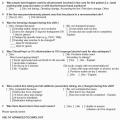A zoonotic illness refers to a disease that is shared between animals and humans.
9 These illnesses are the primary concern of much of the literature concerning the risks to people posed by animals in public settings. In developed countries, these illnesses are relatively uncommon
9 and are even less prevalent in the healthcare setting. However, until more definitive information is available, priority should be placed on patient, visitor, and healthcare provider safety and the use of standard infection prevention measures to prevent animal-to-human transmission of these potential pathogens in healthcare settings.
Contact
Contact with animals includes positive or neutral interactions such as petting, touching, kissing, or being in the direct environment of the animal as well as negative interaction such as biting or scratching.
10 Diseases that can be transmitted by contact include enteric diseases, internal parasites, skin infections, external ectoparasites, and diseases that are consequences of bites or scratches.
10Enteric bacteria and parasites pose the highest risk of disease transmitted from humans to animals in public settings.
11 In the United States in 2012 alone, it was estimated that there were over 400 000 cases of enteric illness attributed to animal contact, almost 5000 hospitalizations, and 76 deaths.
12 Enteric diseases can be transmitted through direct contact with an infected or colonized animal or through environmental contamination. The mechanism of transmission of enteric organisms are fecal-oral, but contact with animal fur, hair, feathers, scales, and saliva can transmit these pathogens due to fecal contamination of the animal or environment.
10 In addition, there have been exposures associated with contaminated animal bedding, cages, environmental surfaces, clothing, shoes, or other objects.
13,14,15,16 Some enteric pathogens can also persist in the environment for long periods of time, documented up to weeks or months in various outbreak investigations.
17,18,19 Susceptibility of people to these pathogens is variable but is influenced by human hygiene practices as well as age, gastric acid suppression, and immune status.
9Other infections associated with animal contact include other bacterial illnesses such as tularemia, leptospirosis, and brucellosis; internal parasites such as
Toxocara,
Toxoplasma, or
Baylisascaris; ectoparasites such as
Sarcoptes mites or fleas; skin infections such as poxviruses (monkeypox, orf, cowpox, etc.);
Mycobacterium marinum (from contact with fish tank water) or
tinea fungi (ringworm); biteassociated infections such as rabies,
Pasteurella multocida,
Capnocytophaga, and other oral pathogens; or scratch-associated infections such as
Bartonella henselae.
10
Droplet and Aerosol
The droplet-associated zoonotic infection of highest global concern is influenza A virus, especially variant strains associated with pigs and birds. There are reports of infections and outbreaks associated with various strains of avian- or swine-associated influenza, though most of these infections reported in the United States are in individuals who have direct contact with pigs.
20 Unfortunately, it has been shown that even apparently healthy pigs and birds may shed influenza virus.
20Notable aerosol transmitted zoonotic illness include Q fever due to the bacteria
Coxiella burnetii, especially due to peripartum animals, tularemia due to
Francisella tularensis, and psittacosis from
Chlamydia psittaci acquired from psittacine birds.
10Fortunately, most illnesses associated with animal contact are acquired in nonhospital settings in facilities like zoos, petting zoos, pet stores, fairs, and farms.
10In addition to the above zoonotic pathogens, in the healthcare environment, there is also the concern that animals can serve as fomites from acquiring infection or colonization with hospital-acquired multidrug-resistant organisms (MDROs) or opportunistic pathogens (such as
Clostridioides difficile) and transmitting them horizontally between patients and/or the environment. In the household setting, studies have shown an interplay between human and animal colonization with bacteria, including pathogens such as methicillin-resistant
Staphylococcus aureus (MRSA).
21 Animals with histories of medical illness and veterinary care may have been exposed to antibiotics and may harbor medically significant multidrug-resistant pathogens such as carbapenem-resistant
Enterobacteriaceae (CRE) or
Pseudomonas.
22 Animal or handler behavior issues can pose a risk to patients, especially those with indwelling devices or disabilities. Finally, there are infection risks associated with animal handlers themselves (similar to any other human visitor to the hospital).
Research animals add an additional complication, as these animals will not be housebroken or behaviorally controlled, and may harbor unique pathogens, based on species or usage in research. Spread of infections from research animals to laboratory workers has been reported, such as ratbite fever (
Streptobacillus moniliformis or
Spirillum minus) from rats and B virus (herpes B, monkey B virus,
herpesvirus simiae) encephalitis from macaque monkeys.
46,47The healthcare setting offers unique challenges for preventing spread of infection from animals to people. Hospitalized patients may have altered host defenses that could increase susceptibility to zoonotic infections and/or increase the severity of clinical disease, and the necessity of sterility and hygiene in the hospital increases potential opportunities for infection. Different populations in the hospital will have different degrees of susceptibility to zoonotic illnesses (pregnant patients, pediatrics, neutropenic patients, oncology patients, etc.) and will potentially interact with animals in different ways. In addition, there is greater regulatory and legal oversight and scrutiny of hospitals than other settings where animals might encounter people. While there will be overlap with other uses of animals in nonhospital public settings, some of the use of animals in hospitals will be unique, such as certain animalassisted activities or research animals.
Despite this increased risk, there are few reports of disease outbreaks directly associated with animals in hospitals, and most fail to identify a causal link (
Table 25-2). In general, there is no evidence that animals carry any more risk of transmitting infection than do people.
32 While there are isolated case reports such as MRSA colonization of the
paws of a cat in a geriatric unit during an MRSA epidemic
24 or a therapy dog with MRSA and
C difficile colonization,
33 formal studies evaluating the potential risks of zoonotic illness in hospitals are lacking.
32 






